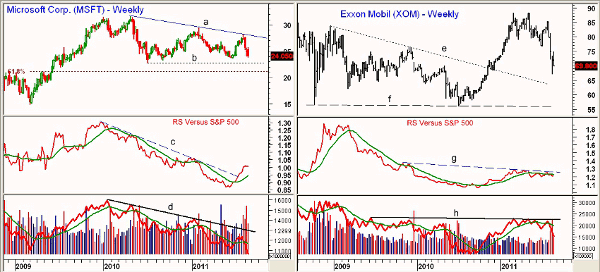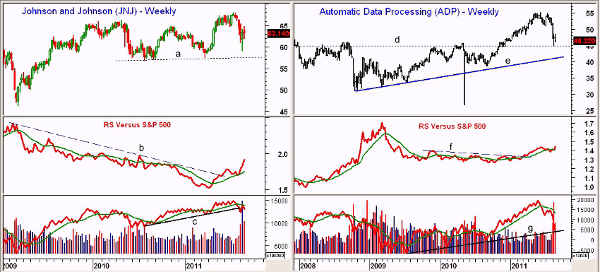These four blue chips are the only S&P 500 companies with AAA credit ratings, a distinction that shows superior financial strength and stability in this or any economic environment.
The downgrade of the United States’ AAA debt rating came as a shock to many and gave investors another reason to sell stocks over the past few weeks. As noted in the The New York Times several weeks ago, the universe of companies whose long-term debt receives the top rating has been shrinking for years.
Thirty years ago, over 60 companies had AAA ratings, but that number had dropped to 15 by the year 2000. Some companies dropped off the list when they were acquired by other companies, while the financial crisis knocked Pfizer (PFE), Berkshire Hathaway (BRK-B), and General Electric (GE) off the list.
The above graphic from The New York Times shows the long-term debt ratings of S&P 500 companies and shows that there are now just four US companies that still have the top rating. Only three companies have AA+ ratings, while the largest concentration of companies are in the BBB class.
Though there is apparently little difference in the borrowing costs between the AAA and AA companies, the relative performance, or RS analysis, of the four AAA-rated stocks indicates that they are acting stronger than the S&P 500.
These companies are Microsoft Corp. (MSFT), Exxon Mobil (XOM), Johnson & Johnson (JNJ), and Automatic Data Processing (ADP).
NEXT: Latest Price Action for Microsoft and Exxon Mobil
|pagebreak|Chart Analysis: Microsoft Corp. (MSFT) tested the weekly downtrend that goes back to the 2010 highs (line a) in late July. From the July highs at $28.14, the stock is down 14.5%, but it is still outperforming the S&P 500.
- MSFT moved below the early-August lows on Monday with next support at $23.65. There is further support at $22.73, which was the low in 2010
- The major 61.8% support is just above $21
- The RS line had been declining since early 2010, indicating MSFT was weaker than the S&P 500. The downtrend, line c, was broken in June, and the RS is now well above its rising weighted moving average (WMA)
- The on-balance volume (OBV) has just made new lows in the past month and is still in a well-established downtrend, line d
- There is first resistance at $25.70 with stronger resistance in the $26.60-$27 area
- MSFT currently yields 2.7%
Exxon Mobil (XOM) peaked with the rest of the energy sector in May (see “Big Oils Big Top”), and the downside target from the double-top formation at $69 was met when the recent low was $67.
- The former downtrend, line e, is now in the $63 area with multi-year support in the $55-$56 area
- The RS line broke through its steep downtrend in 2010 and moved above its weighted moving average by the end of 2010. The RS has been flat for the past few months and a move above resistance at line g will reaffirm its uptrend
- The weekly OBV did not confirm the 2011 highs when it failed to overcome resistance at line h. It is below its WMA and shows a pattern of lower lows
- The daily OBV (not shown) is negative and suggests that the recent lows will be tested
- XOM was up slightly Monday and currently yields 2.7%
NEXT: Latest Chart Action for Johnson & Johnson; How to Profit
|pagebreak|Johnson & Johnson (JNJ) dropped to a low of $59.08 during the early-August panic selloff. The weekly chart shows major support in the $57.50-$56.86 area, line a.
- There is minor support now in the $60-$61.50 area
- The RS broke through its major downtrend, line b, in late May. It tested its rising WMA on the early-August drop before turning sharply higher
- The OBV has slightly violated its uptrend, line c, but is just barely below its weighted moving average
- There is first resistance at $64.85 with stronger resistance in the $66 area
- JNJ was up slightly Monday and currently yields 3.6%
Automatic Data Processing (ADP) peaked in May at $55.12 and by August had dropped back to test weekly chart support in the $47 area, line d. The longer-term uptrend (excluding the flash crash low) is now at $41.20.
- The RS broke out of its trading range (line f) in March and has resumed its uptrend in the past few weeks
- The weekly OBV dropped below its weighted moving average in June and has now reached its major uptrend, line g. It is still well below its WMA
- The daily OBV (not shown) is negative but could form a positive divergence on a drop below the recent lows
- There is initial resistance for ADP at $48.45 with stronger resistance in the $50-$51 area
- ADP currently yields 3.1% and was barely higher in Monday’s trading
What It Means: These four companies have financial strength, which makes their stocks worth watching whether you are expecting a new recession or not. The action on the panic selloff in JNJ in early August is consistent with a correction but not a new bear market.
Currently, only Microsoft Corp. (MSFT) and Johnson & Johnson (JNJ) look attractive on a pullback to the recent lows. I will be watching both ADP and XOM closely for signs they have bottomed as well.
How to Profit: For Microsoft Corp. (MSFT), go long at $23.66 with a stop at $22.28 (risk of approx. 5.8%). On a move above $25.84, raise the stop to $23.44.
For Johnson & Johnson (JNJ), go 50% long at $61.84 and 50% long at $60.56 with a stop at $56.76 (risk of approx. 7.1%).
























